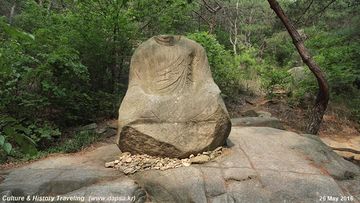삼릉곡 제2사지 석조여래좌상 (삼릉계 석조여래좌상)
| 삼릉곡 제2사지 석조여래좌상 (삼릉계 석조여래좌상) Stone Seated Buddha of the Second Temple Site in Samneunggok Valley (Stone Seated Buddha in Samneunggye Valley) |
|
 younghwan, 경주 남산 삼릉곡 제2사지 석조여래좌상, 통일신라 전성기 불상, 개인 블로그. |
|
| 대표명칭 | 삼릉곡 제2사지 석조여래좌상 (삼릉계 석조여래좌상) |
|---|---|
| 영문명칭 | Stone Seated Buddha of the Second Temple Site in Samneunggok Valley (Stone Seated Buddha in Samneunggye Valley) |
| 한자 | 三陵谷 第2寺址 石造如來坐像 (三陵溪 石造如來坐像) |
| 주소 | 경상북도 경주시 배동 |
|
|
|
해설문
국문
계곡 어귀에 3개의 능이 있어 삼릉계라 하는데, 계곡이 깊고 여름에도 찬 기운이 돌아 냉골[冷谷]이라고도 부른다. 삼릉계곡에는 11개소의 절터와 15구의 불상이 있어 남산에서도 가장 많은 유적이 남아있고, 금오봉 정상으로 이어지는 길이어서 찾는 사람들이 많다.
이 불상은 1964년 8월 동국대학교 학생들에 의해 약 30m 남쪽 땅 속에서 머리(佛頭)가 없는 상태로 발견되어 지금의 장소로 옮겨 놓았다. 이 불상은 왼쪽 어깨에서 흘러내려 매듭진 가사끈과 아래 옷[裙衣]을 동여 맨 끈, 그리고 무릎 아래로 드리워진 두 줄의 매듭이 매우 사실적으로 표현되어 있어 용장사곡 석조여래좌상(보물 제187호)과 함께 복식사 연구의 중요한 자료가 되고 있다. 몸체가 풍만하고 옷주름이 유려하여 통일신라시대에 조성된 것으로 추정된다.
영문
Stone Seated Buddha of the Second Temple Site in Samneunggok Valley (Stone Seated Buddha in Samneunggye Valley)
This stone statue depicting a seated buddha is presumed to date to the Unified Silla period (668-935). It was discovered buried underground in 1964 by students of Dongguk University and placed in its current location, about 30 m to the north of where it was found.
The statue was discovered with its head missing. The body is plump and the folds of the robes drape elegantly, which are characteristic of the period. The details of the buddhas robes, such as the knot at the left shoulder, the knot of the skirt, and long ropes hanging down over the knees, are expressed very realistically, making this statue a valuable resource in the study of fashion history.